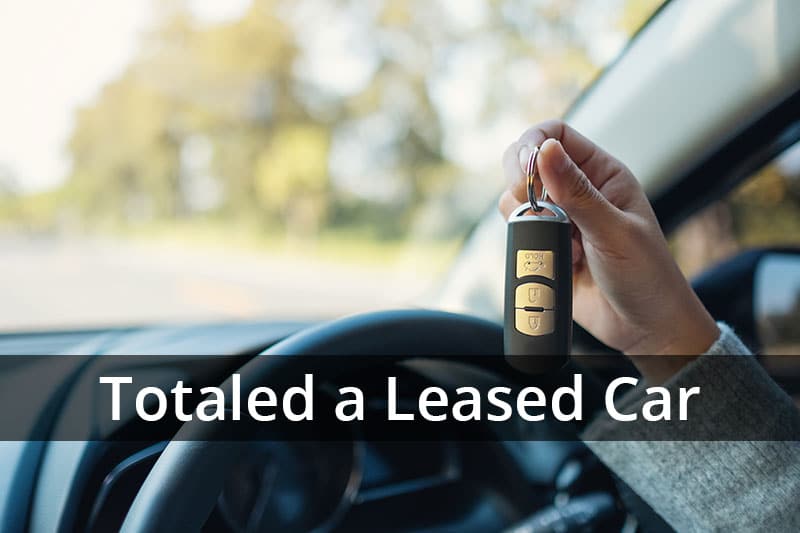Leasing a car is an excellent way to make driving a new vehicle affordable. There are several benefits, including lower monthly payments and the option to trade it in for a newer model in a few years.
One of the drawbacks to leasing a car is that you don’t actually own it. If you have an accident in your leased car, it could cost you.
Before you sign a contract, you may want to know what happens if you total a leased car.
Insuring a Leased Car
In the event of a car accident, the first thing most people ask about is insurance. Having a general understanding of how car insurance works could save you a lot of time and money, especially if you lease a car.
Generally, your coverage must meet the state minimums, but you may want to purchase more to protect yourself.
At the bare minimum, states require drivers to purchase liability insurance before driving any car. Liability coverage pays to repair another driver’s vehicle if the accident was your fault. It usually breaks down to bodily damage and property damage.
Unfortunately, if your liability coverage doesn’t pay for all of the damages, the other driver could sue you to recover the remaining balance. Consider what happens if you cause an accident with more than one vehicle or one that damages another party’s property.
Of note, liability insurance does not cover you or your vehicle if you cause an accident. You may want to consider purchasing additional car insurance options to protect yourself and your assets.
In fact, some leasing companies require additional coverage as part of the lease agreement.
Collision Insurance
While liability insurance covers other drivers and their vehicles, collision coverage pays for your vehicle. Depending on how much coverage you purchase, it can repair or completely replace your totaled car.
Gap Coverage
Gap coverage is one of the best options for leased vehicles. Let’s say your leased vehicle is worth $20,000 at the time of your accident. That’s how much your collision insurance would cover. However, you have $25,000 left on the lease, meaning you are responsible for the $5,000 difference.Â
Unless you purchased gap coverage with your insurance policy, as gap coverage pays the difference between what your vehicle is worth and what you owe on it.
Leased Car Accident: Determining the Damage
Handling an automobile accident is the same for owned and leased cars. It’s important to follow the proper process to cover yourself and get the best outcome.
- Remain at the scene, but move to a safe space if possible.
- If you have injuries, call emergency services.
- Exchange information with the other driver or drivers, including names, phone numbers, registration, and insurance information.
- Do not apologize or admit fault on the scene.
- Take notes about what happened and photograph the scene, including damage to people, vehicles, and the area.
- Gather contact information from any witnesses.
It’s a good idea to contact an experienced car accident lawyer to help you navigate the process and work with your insurance agency on your behalf. Since you leased the vehicle, you also need to notify your leasing company.
Repair or Total the Leased Car?
Once the accident clears and officers release the vehicles, your car will be assessed for damage. Note that you must keep up with monthly payments during the entire process, even if you suspect the car will be totaled.
Depending on the extent of the damage, your insurance company may deem the leased car totaled. Usually, insurance companies find a car to be totaled when the cost to repair it is 65% or more of the total worth.
For instance, if your car is worth $20,000 and the cost to repair it is $17,000, it will likely be a total loss.Â
When you signed the contract for your car, you took responsibility for the vehicle and agreed to return it in serviceable condition. Consequently, if the leased car is a total loss, you owe the remaining balance to the leasing company.
That’s why having sufficient insurance coverage is so critical.
Determining Fault of Car WreckÂ
One of the key factors in any accident is determining who is at fault or who caused the wreck. While it may not be your first concern after a car crash, it will matter as you deal with the fallout and pay for the damages from the accident.
Insurance adjusters consider a lot of information when they determine fault in an accident. Aside from all of the information you collected at the accident (see the list above), your insurance company will examine police reports and speak with witnesses.
Gather as much information as possible to create a clear picture because the other party will likely do the same. Some cases are simple, while others are not as cut and dry. When things get more complicated, you and the other party may share fault.
To further complicate the issue, in shared fault claims, one party could be more at fault than the other. Naturally, things get more complicated if there are no witnesses, and it’s one driver’s word against the other’s.
For example, both drivers were speeding down the highway and collided when they tried to merge into the same lane. However, one driver used their turn signal while the other did not.
The driver who signaled a lane change could be found less liable than the other if they can prove it. Without witnesses to confirm the driver signaled a lane change, they may be held equally responsible.
Types of Fault in a Car Accident
State legislatures put forth laws about car insurance coverage, determining fault, and how to decide when insurance companies pay.
In the United States, there are a few general classifications for determining fault.
- In no-fault states, drivers have personal injury protection as part of their coverage. It pays for damages whether you are at fault or not.
- Comparative negligence states vary depending on your level of fault.Â
- In pure negligence states, you would receive no compensation if you caused the accident.
What if the accident occurs in another state with different rules? For example, Michigan is a no-fault state, but Texas is a modified comparative fault state, meaning that you must prove the other driver was more than 50% at fault for the accident.
How does it work if a Texas driver totals their leased vehicle while on vacation in Michigan?
Usually, the Texan’s coverage will adapt to meet the Michigan rules. In these situations, it’s helpful to retain an attorney who is familiar with the state’s legislation. Of course, the opposite is true for a Michigan driver who ends up in a collision while visiting Texas!
Paying for the Car Accident
When you receive the determination about who is at fault, the result will dictate who pays for the damages. Note that this process can take time, and it’s important for you to keep up with monthly lease payments on your vehicle, even if the car was totaled.
When You Are At Fault for Car Wreck
Obviously, if you caused the accident, you are liable for the damages, but paying for them depends on your state’s guidelines. Even if the accident doesn’t seem costly, you may want to retain an attorney to help you navigate the process. The other party will likely engage legal counsel to advise them and help them get the best possible settlement.
Remember, liability insurance only covers the damage to other people and property that you damage in an accident. Unless you have collision and gap coverage, you would be responsible for your injuries and any damage to your leased vehicle. If you total a leased car, you would owe the leasing company for the car and the amount left on your lease.
What If You Totaled a Leased Car With No Insurance?
Driving without insurance is illegal in most states, meaning you could have much more to worry about than your leased car. You would be liable for all of the damages in the accident, and you could face steep fines for driving without insurance.
What If Someone Hit My Leased Car?
If you cause an accident, you or your insurance cover the damages. Depending on how much coverage you purchase, you may be liable for the remainder. But, what happens if you didn’t do anything wrong?
It can happen to anybody. You’re turning left on a green arrow, but somebody tries to blow through a red light and rams into your car. You sustain several injuries, and the leased car is totaled.
If the other party’s insurance doesn’t cover all of the costs, you would probably have a personal injury claim against the other driver. You could file for all losses related to the accident, including lost wages and medical expenses.
Additionally, sometimes you can ask for money to compensate you for the pain and suffering related to the accident.
Leased Car Totaled: Not At Fault
When your leased car is totaled, but you’re not at fault, you could be looking at a lengthy process. You need to keep up with your monthly lease payments, even if you’re not able to drive the vehicle. Document all of the payments you make because you could request reimbursement from the other driver.
It’s in your best interest to hire an attorney to help you navigate the complex legal issues and determine a personal injury settlement. An experienced attorney can help you determine how much you can request from the at-fault party and guide you through the process. They may be able to help you replace your car and get you back on the road in no time.
Navigating Shared Fault for Car Wreck
Shared fault states create complicated situations for everyone involved. Often, it becomes a case of driver against driver unless there are witnesses or other notable evidence.
Shared fault cases break down into percentages. In some states, if the insurer deems you 45% responsible for the accident and the other driver 55% responsible, payment would mirror those percentages. Other states with modified negligence laws state that whichever driver is more than 50% responsible for the accident is liable for all expenses.
Many states have some version of shared fault, known as comparative negligence. It is extremely complicated, meaning it may be in your best interest to retain legal counsel to help you work through the process.
How Much Can I Get For My Totaled Car?
At the end of everything, you should receive your car’s cash value. The insurance company uses formulas and available information to determine your car’s fair market value or how much the car was worth just before your accident.
Your value, their value, and the leasing company’s value may all differ. Remember that your insurance company doesn’t want to lose money and may shortchange you on the value. You can negotiate with them to increase your settlement. You can help the process with a few key steps.
- Research on your own across reliable sites, like Kelley Blue Book.
- Check out local dealers and your leasing company to see what similar cars go for in the area. Local pricing can help or hinder your goal.
- Track all of the upgrades and special features you have in the vehicle. Pull out receipts from work you had done, recent tune-ups, and even mileage if yours is especially low.
If you retained an attorney, they probably did some research about this already. They may have knowledgeable connections that have helped with similar circumstances.
Final Thoughts About What Happens If You Total a Leased Car
Every accident is scary and can be overwhelming as you navigate the legal and financial fallout. It doesn’t matter who caused the accident; you will still have paperwork and phone calls to deal with while you heal.
Dealing with a totaled leased car may be more difficult if you have significant injuries or can’t work because you don’t have a car. Hiring a reputable attorney could make all the difference for you and your family.
From dealing with the insurance company to helping you work through the legal aspects, an experienced lawyer can make sure you receive a fair settlement.Â
Contact Stoy Law Group
If you have any questions about your car wreck or would like to speak to a lawyer, contact our office today.














